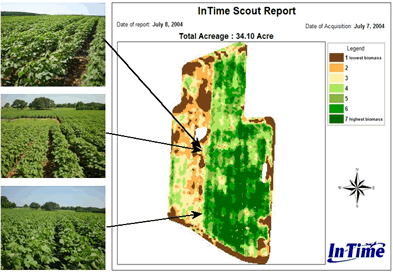The seven color image above shows a classified aerial image of a
cotton field in north Alabama. The field was planted in one
variety. The field slopes down from east to west. The western half
of the field usually yields better than the eastern half. The
grower uses our services for variable rate spraying of cotton with
growth regulators and defoliants. He knows his fields well enough
to write prescriptions without scouting the fields with the
classified imagery.
However,
the difference seen in the classified image surprised him enough
to drive 40 miles to look at the field. The bottom picture on the
left was taken on the line where the classified image showed a
distinct transition from a classes 2 and 3 to a classes 6 and 7.
In the field it was hard to pick out visually the difference
between cotton on the western side (Class 2 and 3) and cotton on
the eastern side (Class 6 and 7) of the field.
In the end, the grower remembered that the
litter truck started on the east side and ran out about 3/5 down
in the middle of the field. Approximately 2 to 3 tons of litter
was applied. The west side of the field received a commercial
fertilizer. The grower was aiming to apply the same amount of
nitrogen over the whole field.
Surprises like this do not stand alone. Many fields are
treated differently from one end to the other for whatever reason.
To maximize profits it is important to treat each area in the
field individually. In the above case, the eastern side of the
field might need a little more growth regulator to prevent too
much vegetative growth.
Download
printable version

|

